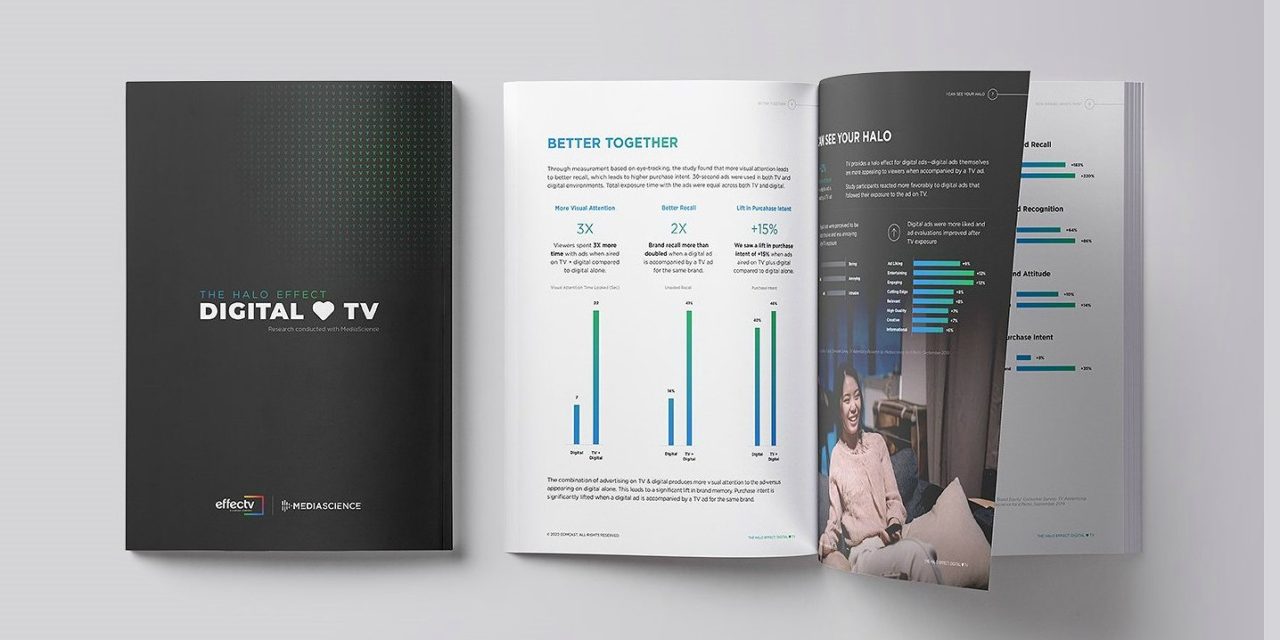Author: Simon Applebaum
Source: www.mediavillage.com, September 2020
Comcast‘s ad sales division, Effectv, introduces a new appeal to the advertising community this week. If any of your campaigns solely use commercials on YouTube, Facebook or other social media, they’ll be more impactful when you distribute them on television services, as well.
That’s the big takeaway of “Digital Loves TV,” a study of consumer behavior from Effectv and independent research lab MediaScience. A white paper documenting the study is available to advertisers, ad agencies and media buying firms today. One key finding: consumers are 35 percent more likely to purchase a brand, product or service unknown to them beforehand after watching a commercial for it on TV and digital, compared to exposure on digital alone.
“What we found is, as video consumption habits have changed, advertisers naturally follow their audience to digital experiences,” said John Brauer, executive director of advanced analytics at Effectv. “But we know TV’s a trusted, brand-building mechanism for our advertisers. We started with the question: How effective is a digital-only campaign at building a brand, relative to those that combine digital with TV? We found that across the board, all of your brand metrics improve when you combine digital with TV.”
More than 140 adults age 18 and over participated in the study, taking place at two of MediaScience’s lab facilities. During the study, participants watched a set of commercials on digital services (YouTube/Facebook/mobile apps) and TV networks. The sequence of commercials and where they showed up was juggled throughout the test period, so that the entire sample base did not experience the same presentation order and platform.
Some of the messages were for well-known brands, while others were for products unknown to the viewers — imaginary and created just for this effort. MediaScience technicians used biometrics, eye tracking and other procedures to monitor the test period.
Brauer maintains the study’s sample size, at 140-plus people, was appropriate “to get statistically significant results.” He declined to name the advertisers with commercials running in the test, and acknowledged a variety of categories were in play, including retail, home improvement and autos.
“There’s a level of legitimacy that TV creates for a brand, as opposed to if you’re only advertising on digital” Brauer continued. “The intent to purchase doesn’t carry through at the same level as those campaigns that had the audience exposed to both TV and digital. The effect actually stands for both known and unknown brands.”
Other conclusions of this study:
— A digital/TV combined campaign improves that campaign’s total performance.
— Popular brands, products and services consumers know and trust by heart benefit from commercial exposure on both platforms, and brands, products and services people don’t know or use benefit more.
— Viewers pay attention and spend more time watching commercials on digital services when preceded by TV exposure to those ads.
With distribution of “Digital Loves TV,” Effectv is helping its clients to understand and find better ways to use their media budgets. “This evolution of TV comes down to how we as viewers program ourselves and have the content we want to watch at the right time,” Brauer asserted.
For small local businesses as well as new national advertisers on the scene, such as direct-to-consumer marketers, the study’s conclusions can be critical to their future existence. “We’re there to help them understand that (using TV) isn’t this big challenging mystery,” Brauer added. “It’s something that anyone can do, and it’s important for them to activate (TV elements in their campaigns) in order to make that next step with their brand.”
Expect a number of research initiatives from Effectv in the near future that further probe the viewer relationship between digital and TV messages. Chances are they are not necessarily two different islands of ad activity, Brauer noted. “We see this as one media ecosystem in that the resonance of your messaging carries across those platforms.”
Could the surging number of ad-supported programming ventures circulating through smart TV sets and TV-connected gadgets — including Peacock from Comcast’s NBCUniversal outpost — benefit as well over time from these studies? Over time we’ll find out, Brauer suggested.
Click the social buttons to share this story with colleagues and friends.
The opinions expressed here are the author’s views and do not necessarily represent the views of MediaVillage.com/MyersBizNet.

